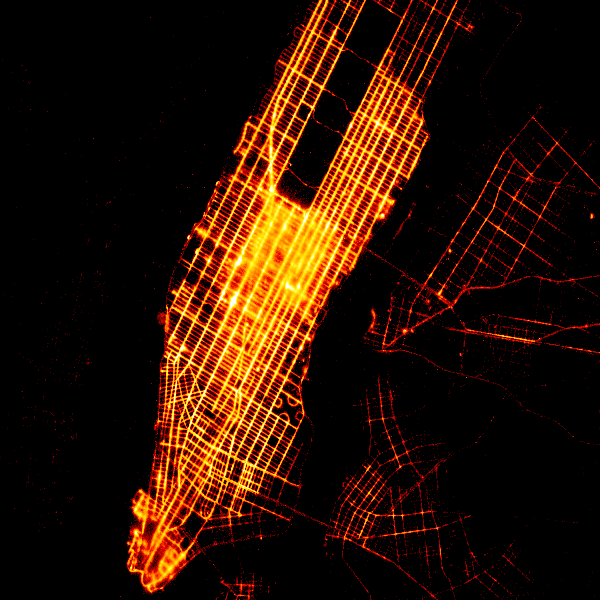datashader-cli
Quick visualization of large datasets using CLI based on datashader.
Installation
Use pip
pip install datashader-cli
Use pip from Github
pip install git+https://github.com/wybert/datashader-cli.git
Quick Start
Visualize 10 million NYC taxi trip data points in Gigabytes.
Create a shaded scatter plot of points and save it to png file, set background color to black.
datashader_cli points nyc_taxi.parquet --x pickup_x --y pickup_y pickup-scatter.png --background black

Visualize the geospaital data, support Geoparquet, shapefile, geojson, geopackage, etc.
datashader_cli points data.geo.parquet data.png --geo true

Use matplotlib to render the image, matplotlib will enable the colorbar, but it can’t use spread function
datashader_cli points data.geo.parquet data.png --geo true --matplotlib true

Usage
datashader_cli --help
# sage: datashader_cli [OPTIONS] COMMAND [ARGS]...
# Quick visualization of large datasets using CLI based on datashader.
# Supported data format: csv, parquet, hdf, feather, geoparquet, shapefile,
# geojson, geopackage, etc.
# Options:
# --help Show this message and exit.
# Commands:
# points Visualize points data.
Quick visualization of large point datasets using CLI based on datashader.
datashader_cli points --help
# Usage: datashader_cli points [OPTIONS] DATA_PATH OUTPUT_APTH
# Visualize points data.
# Options:
# --x TEXT Name of the x column, if geo=True, x is optional
# --y TEXT Name of the y column, if geo=True, y is optional
# --w INTEGER How many pixels wide to make the image
# --h INTEGER How many pixels high to make the image
# --x_range TEXT Range of the x axis, in the form of "xmin,xmax"
# --y_range TEXT Range of the y axis, in the form of "ymin,ymax"
# --agg TEXT Aggregation function, e.g. "mean", "count", "sum", see
# datashader docs
# (https://datashader.org/api.html#reductions) for more
# options
# --agg_col TEXT Column to aggregate on, e.g. "value"
# --by TEXT Column to group by, e.g. "category", see datashader
# docs (https://datashader.org/api.html#reductions) for
# more options
# --spread_px INTEGER How many pixels to spread points by, e.g. 1, see https
# ://datashader.org/api.html#datashader.transfer_functio
# ns.spread
# --how TEXT How to map values to colors, valid strings are
# ‘eq_hist’ [default], ‘cbrt’ (cube root), ‘log’
# (logarithmic), and ‘linear’. see https://datashader.or
# g/api.html#datashader.transfer_functions.set_backgroun
# d
# --cmap TEXT Name of the colormap, see https://colorcet.holoviz.org
# for more options
# --geo BOOLEAN Whether the data is geospatial, if True, x and y are
# optional, need Geopandas installed to use this option,
# supported data format: Geoparquet, shapefile, geojson,
# geopackage, etc.
# --background TEXT Background color, e.g. "black", "white", "#000000",
# "#ffffff"
# --matplotlib BOOLEAN Whether to use matplotlib to render the image, if
# True, need matplotlib installed to use this option.
# Matplotlib will enable the colorbar, but it can't use
# spread function
# --help Show this message and exit.
Credits
- Free software: MIT license
- Documentation: https://wybert.github.io/datashader-cli
Features
- point data visualization

